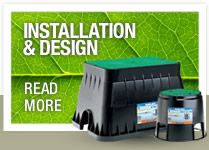You are here: Home > Amazon Irrigation > FAQs | Amazon Irrigation
FAQs | Amazon Irrigation
Below are some helpful FAQ's regarding our services and Irrigation garden products
What is water flow and how can I measure it?
Flow is the quantity of water passing through a hose in a given unit of time; it is measured in litres per minute (l/m) or per hour (l/h). To measure the flow of your system, all you need is a chronometer and a recipient with a known capacity, for example a 5-litre jerry can. Open the tap as much as possible, then measure the time required to fill the can, then make a simple calculation. If the 5-litre can fills in 10 seconds, water flow is one litre every two seconds, i.e. 30 litres per minute.
What exactly is water pressure and how is it measured?
Imagine the water contained in the system in the form of a column; the weight exerted by the column on its base is the pressure. Measured in BAR, pressure is defined "static" when the system is closed, "dynamic" when it is operating. Dynamic pressure is always lower than static pressure, because of the flow resistance caused by surface friction inside the water hose: the narrower and longer the hose, the greater the flow resistance. You should know the dynamic pressure of your water system, as it should be sufficient to ensure proper operation of watering devices. Refer to the table in the Claber guide to calculate your water pressure, quickly and easily.
How can I install an underground irrigation system myself?
Thanks to the range of Claber products, anyone can make their own underground irrigation system, with the help of two special tools: the Claber Irrigation Guide, containing all necessary information and advice, and the Claber Planning Service (available from your nearest Claber dealer), which can draw up a customised project. All the tools you need are a set of stakes and some string to mark out the route of the circuit tubes on the lawn, a spade to dig the trenches and a saw, to cut the tubes to the required lengths. The Claber underground irrigation range includes a comprehensive selection of compression connectors, designed for watertight connection of tubes without the need for special tools or materials; in fact, all other components of the system, from the sprinklers to the final drainage plug, can be simply screwed on.
Claber has developed a solution that is specially designed for gardens between 50 and 200 m2: the Colibrì System. No need to dig: all you have to do is mark out the trench by levering the spade back and forth in the earth. Virtually no effort is required and no damage is done to the lawn. And there’s no need for special electrical or water connections either: just a battery-powered Claber timer connected directly to the tap, to assure even, waste-free watering of your garden by special Colibrì micro-sprinklers.
Can I use an Aquadue Duplo two-way timer with two different irrigation systems, for example a drip system and an underground one?
In a short answer yes. You can use the same timer for pop-up irrigation on your lawn and use the other line for drip irrigation in your shrub bed.
Can I use Colibrì micro-sprinklers and Claber pop-ups on the same line?
It’s not recommended, because these two systems have different types of operating modes and water requirements. The same goes for stationary sprinklers and soaker hoses; if they were installed on the same line, some parts of the garden would receive too much water, other parts not enough. The best solution is to set up different circuits, each for a particular type of irrigation system.
Is it true that irrigation systems should have a "ring" configuration?
A closed-circuit configuration is not at all necessary; the important thing is that the tube diameter is sufficient and that flow capacity and resistance are correctly calculated.
Can solenoid valves be left in their boxes during winter, or should they be removed?
Valve boxes are designed to protect valves from cold and frost. In any case, it is a good idea to install a drainage valve at the end of the line to ensure that the circuit is completely empty, as an added precaution.
What is the best way of watering hedges, flower beds and medium-sized plants?
Claber recommends a micro-sprinkler system, or even simpler products, such as dripper or soaker hoses, which when positioned on the ground near the plants, water the roots without causing any damage to foliage.
What is an Aquastop connector?
A special automatic connector that stops water flow when the hose is disconnected from a pistol, spray nozzle or sprinkler, without the user having to turn off the tap. This kind of connector is particularly convenient when switching from one accessory to another on the same hose.
How much maintenance is required with a system?
System maintenance is generally minimal and limited to regular visual inspections throughout the growing season to ensure equipment is operating correctly. Claber equipment is very reliable however sprinkler nozzles and pumps will wear over time. We operate maintenance contracts for our larger systems to ensure that they operate efficiently over many years.
What do I do if mains water pressure is too high?
To solve this problem, install a pressure reducer/stabiliser on the tap supplying the system, to ensure optimal pressure to the sprinkler type used (Colibrì, micro-sprinklers, etc.).
What is the best time to water plants?
The best time is in the morning and evening, particularly during summer. Watering in the evening has the extra advantage of keeping the soil moist for longer, because there’s no risk of evaporation caused by sunlight. In the early morning, the light and warmth of day improve the assimilation of the nutritional elements contained in the soil. Watering should be totally avoided during the hottest hours of the day, when the shock caused by the low temperature of the water can adversely affect plant health not to mention the waste of water, which evaporates even before it reaches the plant roots. Furthermore, residual water droplets act as small magnifying glasses, concentrating the sun’s rays until they eventually burn the leaves.











